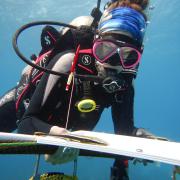The Smithsonian Scientific Diving Program (SDP) consists of the Central Diving Office as well as multiple Smithsonian Diving Units.
The Central Diving Office (CDO), located in Washington DC, provides oversight and support for all diving operations under the auspices of the Smithsonian Institution (SI). Positions within the CDO include the Scientific Diving Officer and the Assistant Scientific Diving Officer.
There are five operationally based Dive Units within the SDP. The National Museum of American History, National Museum of Natural History (includes Smithsonian Marine Station Fort Pierce and Carrie Bow Field Station), National Zoological Park, Smithsonian Environmental Research Center, and the Smithsonian Tropical Research Institute, all have diving components and each having a Unit Diving Officer, which function under the direction of the Central Diving Office.
To learn more about SDP staff, see below:
Scientific Diving Officer - Central Dive Office
Zach Foltz
Zach Foltz, as the Diving Officer and Station Manager of the Smithsonian’s field station on Carrie Bow Cay, Belize (Caribbean Coral Reef Ecosystems Program), has logged over 800 scientific hours underwater. Along with his Diving Officer duties and maintaining a remote field station off the coast of Belize, Foltz is involved in ocean monitoring programs around the world.

Raul De Leon
Raul De Leon came to the Smithsonian Scientific Diving Program from a robust career as a Manager and Dive Instructor of Panama Dive Adventure and Safety Diver for Survivor Films Ltd. He is the recipient of the 2015 Member’s Choice Award presented by the Divers Alert Network. De Leon works diligently to promote the culture of diving safety throughout all diving related activities at STRI.

Diving Officer – National Museum of American History, Washington DC
Paul F. Johnston
Paul F. Johnston is Curator of Maritime History at the Smithsonian’s National Museum of American History, where he is responsible for the maritime history and National Watercraft collections. He has curated more than a dozen exhibitions at the Smithsonian and other museums, including On the Water: Stories from Maritime America and The Norie Marine Atlas & The Guano Trade. He also consults internationally with other museums on their exhibitions and other affairs, and he serves on national and international committees for the US Department of State, US Navy, the Council of American Maritime Museums, the American Association of Museums, the Society for Historical Archaeology, and the Advisory Council on Underwater Archaeology. Johnston’s research area is shipwreck archaeology, and he has worked on shipwrecks in the Mediterranean and Baltic Seas, the Atlantic, Pacific and Indian Oceans, the Great Lakes and many smaller lakes and rivers. He has over 100 publications, ranging from eight books to numerous scientific and general-interest articles and reviews. He has just published the book Shipwrecked in Paradise: Cleopatra’s Barge in Hawai‘i on the early 19th century Royal Yacht of Hawaiian King Kamehameha II. This book won the Smithsonian Secretary’s 2016 Research Award. Johnston holds a B.A. in English Literature from Middlebury College and a Ph.D. in Anthropology from the University of Pennsylvania.

Diving Officer – National Zoological Park, Washington DC
Richard Quintero
Richard joined the SDP in 2012 and became the National Zoo and Conservation Biology Institute Unit Diving Officer in 2015. A significant portion of the diving operations at NZCBI is dedicated to the care and maintenance of aquatic animal habitats at the Rock Creek Campus.

Diving Officer – Smithsonian Environmental Research Center, Edgewater MD
Emily Anderson
Emily Anderson serves as the Unit Diving Officer for the Smithsonian Environmental Research Center (SERC) and provides oversite to all SERC diving activities. Along with her Diving Officer duties, Anderson is a technician in the Fisheries Conservation Lab and the MarineGEO program. Anderson is involved in long term fisheries research and habitat monitoring in the Chesapeake Bay and around the world.

Diving Officer - National Museum of Natural History, Smithsonian Marine Station Fort Pierce, FL and Carrie Bow, Belize
Zach Foltz
Zach Foltz, as the Diving Officer and Station Manager of the Smithsonian’s field station on Carrie Bow Cay, Belize (Caribbean Coral Reef Ecosystems Program), has logged over 800 scientific hours underwater. Along with his Diving Officer duties and maintaining a remote field station off the coast of Belize, Foltz is involved in ocean monitoring programs around the world.

Diving Officer – Smithsonian Tropical Research Institute, Panama
Raul De Leon
Raul De Leon came to the Smithsonian Scientific Diving Program from a robust career as a Manager and Dive Instructor of Panama Dive Adventure and Safety Diver for Survivor Films Ltd. He is the recipient of the 2015 Member’s Choice Award presented by the Divers Alert Network. De Leon works diligently to promote the culture of diving safety throughout all diving related activities at STRI.
